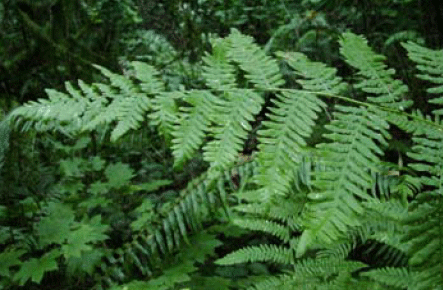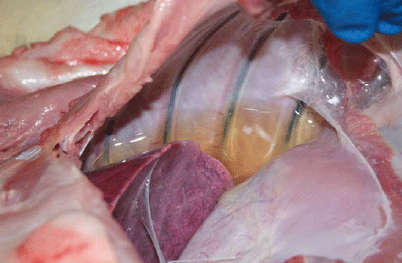



Bracken Poisoning in Pigs
Bracken poisoning is rarely reported in pigs in the UK - including three last year - but cases must be reported to the authorities as they represent a potential danger to human health from the consumption of the meat.This alert has been prompted by the recent diagnosis of three cases of bracken poisoning in pigs submitted to AHVLA since September 2012. There have been a total of 12 AHVLA diagnoses of likely bracken poisoning in pigs since 2007, bracken representing 12 of 13 cases of plant poisoning in pigs during this period. The other plant poisoning diagnosed was hemlock causing congenital limb deformities in piglets. Figure 1 shows growing bracken fern.

In pigs, bracken poisoning causes a cardiomyopathy and heart failure and
post-mortem findings reflect this with pulmonary oedema, pleural effusion (see Figure 2) and, sometimes pallor of the myocardium. Clinical signs may be predominantly respiratory distress and dyspnoea but, in many of the AHVLA cases, pigs were found dead without signs having been seen. Ataxia was reported in one case prior to death. Differential diagnoses for the gross lesions include mulberry heart disease, PCV2 associated disease, fumonisin toxicity, encephalomyocarditis virus and other causes of heart failure, e.g. congenital defect, endocarditis and histopathology, is necessary to confirm the diagnosis, together with a history of exposure to bracken. Harwood and others (Veterinary Record (2007) 160:914-915) give a full description of two typical cases.
Most cases occur in small outdoor groups of pigs with less controlled paddocking than in commercial pig herds and with access to heathland, woodland or fell where bracken is present. Six cases have been diagnosed by AHVLA laboratories in Wales, five by Winchester and one by Penrith. Bracken toxicity in pigs usually results from exposure over a prolonged period and is due to the
thiaminase toxic component. The rhizomes and young leaves contain most thiaminase, thus natural rooting by pigs and access to growing bracken both predispose to ingestion and toxicity.

(Image courtesy of Andrew Holliman, AHVLA Penrith)
There is not a clear seasonal distribution of the cases which were diagnosed in all months except May and June, although eight occurred between July and December compared to four between January and April. Poisoning occurs in areas where pigs have access to bracken growing naturally and the toxicity and palatability of bracken can vary with season, growth and locality. Poisoning could also occur if bracken was incorporated into pig bedding. All the 12 AHVLA cases have been in growing pigs three to seven months old and age may affect susceptibility, however deaths in sows after long-term bracken exposure have been reported (Lund, Pig Journal (1984) 13: 96-97).
If pigs are grazing known bracken-infested land for long periods or cases of poisoning are diagnosed then supplementation with thiamine should be considered.
Bracken poisoning is reportable to Food Standards Agency as a potential food safety incident and pigs must be withdrawn from potential exposure to bracken for at least 15 days prior to slaughter for human consumption of meat and offal.
You can find out more about the risk to consumers from eating foods derived from animals that had eaten bracken from the UK Committee on the Toxicity of Chemicals in Food, Consumer Products and the Environment by clicking here.
February 2013








